Last modified: 20 December 2013
Tuesday, 26 April 2011
As a royalty watcher you should of course arrive at the place-to-be in time. So on Tuesday, 26 April 2011 I took the airplane from Amsterdam to London, where I had booked a hotel already late November. Not too close to Westminster Abbey and Buckingham Palace, but close to Paddington Station. A friend of mine, Anuschka, flew in earlier on the same day from Germany. I met her at Westminster Abbey after she had visited it. I was too late to get in, but I had been there before, so I didn’t mind that much. The first people were already camping on the street in front of the huge press stand with good view on the entrance of the Abbey. We had a quick look at Hatchard’s, the royal bookshop at Piccadilly, before heading back for the hotel to have dinner nearby. I bought a special edition Oyster card of the wedding by the way.
Wednesday, 27 April 2011
As there was nothing on the royal wedding programme, and we both had never been to the former royal residence Hampton Court Palace, we took the train there on Wednesday morning. Lots of things to do and to see there, so I am sure we still missed some parts. But we met some “royals” walking around, and enjoyed the beautiful gardens. Of course the end of April is quite a good time to visit the palace if you love gardens. Happily the whole week the weather was nice, not too hot, a bit too much cold wind, but dry. We had read there was to be a wedding rehearsal at Westminster Abbey on Wednesday, but it was not known when.
From the train back to London we saw helicopters circling above the abbey and thought we would be too late. But when we came there, we overheard journalists saying that the rehearsal might take place soon. Unfortunately after about one hour waiting (5pm) everybody was sent away from the entrance of the Abbey. Still it took until 7.20pm until Prince William and Catherine Middleton finally arrived, and disappointed everyone. Three cars with dark windows passed us very quickly, drove past the entrance to a side building, and disappeared under the gate. No opportunity to see anything. We had a last look at the people camping on the other side of the street, and then went back to the hotel and had dinner.
Thursday, 28 April 2011
Tired after all the walking Anuschka and I decided not to do too much on Thursday. We had a look at Buckingham Palace, where the last changing of the guards before the wedding took place about half an hour too late. When we walked in the direction of the Buckingham Palace shop we suddenly heard somebody shouting my name. It turned out that, like us, our internet acquaintance Ken – whom I had met before – also was walking around to see what was going on. We had a look at the Goring Hotel, where halfway the day already tens of journalists and photographers were standing. The bride was only to arrive in the evening to stay her last night before the wedding there with her family. We had a quick look at the Buckingham Palace shop afterwards, but the shop was so crowded that we went outside as quick as possible. Too scared to break something, and too lazy to queue to pay for anything.
Reception at the Mandarin Oriental Hotel
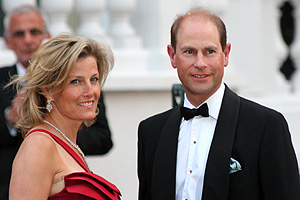

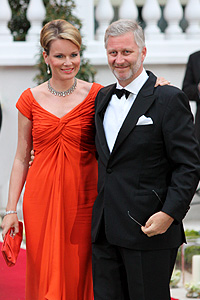
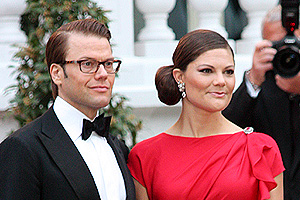
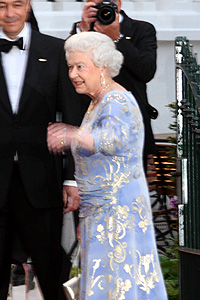
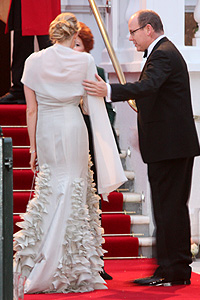
All photos: Copyright Anuschka Becker (sorry I don’t have bigger versions anymore)
In the late afternoon Anuschka and I left for the Mandarin Oriental Hotel to have a look at the pre-wedding reception at the hotel. Unfortunately it turned out we were later than we thought, so it took a bit of time to find a good view on the entrance of the hotel. And to be honest we only got a good view when most of the guests had already arrived. The event was officially hosted by Lady Elizabeth Anson, who welcomed the guests outside the hotel. Bride and groom didn’t attend the reception, but many of the royal guests from Great Britain and abroad showed up. The guests included Queen Elizabeth II of Great Britain and the Duke of Edinburgh, as well as the Prince of Wales and the Duchess of Cornwall.
We were especially delighted to see some royals we had never seen before. Unfortunately a few royals, like the Prince of Orange and Princess Máxima of the Netherlands stayed at the hotel and didn’t come out to show what they were wearing. The last ones to arrive were reigning Prince Albert II of Monaco and his fiancée Charlene Wittstock. When almost everybody was inside my friend Christine from the Netherlands arrived. She had only been able to fly to England on Thursday evening. I also spoke briefly with two visitors of my website who recognised me: a photographer from Great Britain and a Dutch woman living in London. Soon after the start of the party the Prince of Wales and the Duchess of Cornwall already left again to be with the groom on his last evening as a free man. We left soon too, to have a late dinner.
Wedding day, Friday, 29 April 2011
Programme
- 8.15 -9.45am – The general congregation will arrive at the Great North Door of Westminster Abbey.
- From 9.50am – Governors-General and Prime Ministers of Realm Countries, the Diplomatic Corps, and other distinguished guests arrive at Westminster Abbey.
- 10.10am – The Bridegroom and Prince Henry of Wales leave Clarence House for Westminster Abbey. They arrive at the Abbey at 10.15am.
- 10.20am – Members of Foreign Royal Families arrive at Westminster Abbey from Buckingham Palace.
- 10.20am – Mrs. Michael (Carole) Middleton and Mr. James Middleton leave the Goring Hotel for Westminster Abbey. They arrive at the Abbey at 10.27am.
- 10.25am – Most members of the Royal Family leave Buckingham Palace for Westminster Abbey. They arrive at the Abbey at 10.30am.
- 10.35am – The Duke of York Princess Beatrix and Princess Eugenie of York, The Earl and Countess of Wessex, The Princess Royal and Vice Admiral Timothy Laurence leave Buckingham Palace for Westminster Abbey. They arrive at the Abbey at 10.40am.
- 10.38am – he Prince of Wales and The Duchess of Cornwall leave Clarence House for Westminster Abbey. They arrive at the Abbey at 10.42am.
- 10.40am – The Queen and The Duke of Edinburgh leave Buckingham Palace for Westminster Abbey. They arrive at the Abbey at 10.45am.
- 10.48am – The Bridesmaids and Pages leave the Goring Hotel for Westminster Abbey. They arrive at the Abbey at 10.55am.
- 10.51am – The Bride, accompanied by Mr. Michael Middleton, leaves the Goring Hotel for Westminster Abbey.
- 11.00am – The Marriage Service begins. The Marriage Service will be relayed by audio speakers along the Route.
- 12.15pm – The Carriage Procession of the Bride and Bridegroom with a Captain’s Escort of the Household Cavalry, followed by The Queen’s Procession with a Sovereign’s Escort of the Household Cavalry, leaves Westminster Abbey for Buckingham Palace.
- 12.30pm – The Bride’s Carriage Procession arrives at Buckingham Palace.
- 12.40pm – Members of the Royal Family and Members of Foreign Royal Families arrive at Buckingham Palace.
- From 12.40pm – Other guests for the Reception arrive at Buckingham Palace.
- 1.25pm – The Bride and Bridegroom, together with their Families, appear on the balcony of Buckingham Palace.
- 1.30pm – Fly Past by the Royal Air Force and Battle of Britain Memorial Flight.
- In the evening about 300 guests have been invited to the wedding dinner at Buckingham Palace given by The Prince of Wales. The dinner will be followed by a dancing.
Westminster Abbey
Westminster Abbey has a long history. In the middle of the tenth century the first Benedictine monks came to the site and established a tradition of daily worship. The eastern part of the 11th century abbey was founded by King Edward the Confessor and dedicated in 1065. The gothic building of the present-day church was begun in 1245 by King Henry III. He also provided a new shrine for the church’s saint, St Edward. Henry III had also laid the foundation stone for a new Lady Chapel, which early 16th century was replaced under King Henry VII. There has always been a link between the Abbey and the Royal Family of the country.
Since 1066 the Abbey has been the coronation church of the English and British monarchs. The Abbey thus far has witnessed 38 coronations. The first documented one was the coronation of William the Conquerer in 1066. The Abbey is also the resting place of seventeen monarchs. The last monarch to be buried here was King George II in 1760. Because of lack of space after this time the monarchs were buried at Windsor. However the Abbey has hosted only sixteen royal weddings, including the new Duke and Duchess of Cambridge.
Flower decoration
Prince William and Catherine Middleton have chosen London-based floral designer Shane Connolly to create the floral displays for their wedding. Mr Connolly has directed a team of florists, including Westminster Abbey’s and Buckingham Palace’s florists, and florists individually chosen by the couple, to create the floral displays at the Abbey and for Buckingham Palace.
The Couple have taken a close interest in the designs, which follows a theme that pays tribute to the Language of Flowers. The floral displays in Westminster Abbey featured a variety of seasonal growing and cut British flowers and trees sourced from Royal Estates and other growers around the country. The flowers and plants included blossoms, azaleas, rhododendron, euphorbias, beech, wisteria and lilac.
The floral displays in the Abbey included eight 20 feet-high trees: six English Field Maple and two Hornbeam. All the trees were growing in planters, which have also been designed by Mr. Connolly and which were made by craftsmen at Highgrove, The Prince of Wales’s Residence in Gloucestershire. After the wedding, the flowers and plants were left in position in Westminster Abbey for the public to view until Friday 6th May 2011. Following this, many of the trees were taken to Highgrove Gardens, where they were planted. The Couple’s intention is that many of the cut plants and flowers and all the growing plants will be donated to charities or re-planted.
The trees, plants and flowers were being sourced from the Saville Gardens and Valley Gardens in Windsor Great Park, Sandringham Estate and other English growers.
Various wedding facts
Around 1900 people were invited to the service at Westminster Abbey. Around 650 people were invited to the reception at Buckingham Palace afterwards. Around 300 people were invited to the wedding dinner at Buckingham Palace in the evening. These 300 guests were family and close friends.
The Wedding Service was relayed by audio speakers along the Route. This is in addition to the screens at Hyde Park and Trafalgar Square.
For the first time, broadcast footage of a royal wedding was to be live streamed on The Royal Channel on YouTube, accompanied by a live multi-media blog put together by St James’s Palace.
An official video “Wedding Book” on YouTube invited anyone to submit their own video of congratulations to Prince William and Catherine Middleton. The video messages will provide a unique reminder of the day for the couple.
On the day of his wedding, Prince William was created Duke of Cambridge, Earl of Strathearn and Baron Carrickfergus.
Seating plan
North Lantern
Miss Middleton’s immediate family and friends
Prince William and Miss Middleton’s friends
The Spencer Family
South Lantern
The British Royal Family
Members of Foreign Royal Families
North Transept
Prince William and Miss Middleton’s friends
South Transept
Governors General
Members of the Diplomatic Corps
Middleton Family friends
Stalls North
Representatives of the Church and other Faiths
Prince William and Miss Middleton’s Friends
Stall South
Members of the Cabinet· Prince William and Miss Middleton’s Friends
North Nave
Guests of the Prince of Wales
Members of the General Congregation
South Nave
Representatives of the Church and other Faiths
Members of the General Congregation
The following Members of the Royal Family were seated on the front row (South Lantern), in order starting closest to the Sacrarium:
Queen Elizabeth II of Great Britain
The Duke of Edinburgh
The Prince of Wales
The Duchess of Cornwall
Prince Harry of Wales
The following members of the Middleton Family were seated on the front row (North Lantern), in order starting closest to the Sacrarium:
Mrs. Carole Middleton
Mr. Michael Middleton
Mr. James Middleton
The following members of the Spencer Family were seated on the front row of their block (North Lantern), in order starting closest to the Sacrarium:
The Lady Sarah McCorquodle
Mr. Neil McCorquodale
Mrs. Anne Wake-Walker
The Lord Robert Fellowes
The Lady Jane Fellowes
The Earl Spencer
Miss Karen Gordon
The wedding service
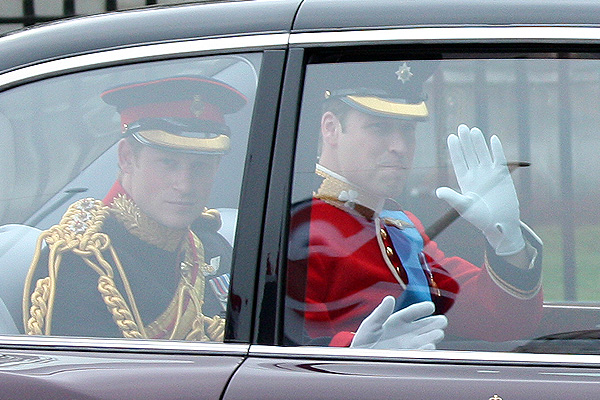
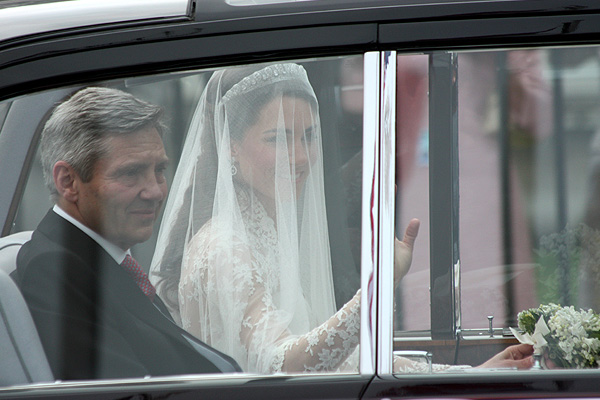
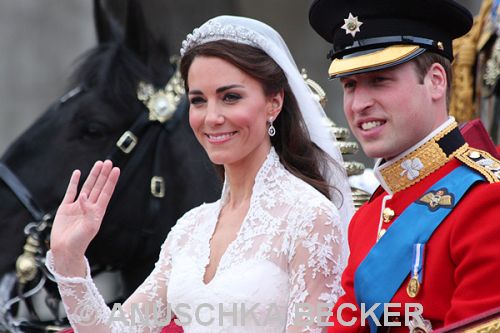
All photos: Copyright Anuschka Becker (sorry I don’t have bigger versions anymore)
The marriage was conducted by the Dean of Westminster, the Very Reverend John R. Hall. The Archbishop of Canterbury, the Most Reverend and Right Honourable Rowan Douglas Williams, married bride and groom. The Bishop of London, the Right Reverend and Right Honourable Dr Richard John Carew Chartres, gave the address.
Bishop’s Sermon
During the wedding ceremony the Bishop of London held a sermon.
“Be who God meant you to be and you will set the world on fire.” So said St Catherine of Siena whose festival day it is today. Marriage is intended to be a way in which man and woman help each other to become what God meant each one to be, their deepest and truest selves.
Many are full of fear for the future of the prospects of our world but the message of the celebrations in this country and far beyond its shores is the right one – this is a joyful day! It is good that people in every continent are able to share in these celebrations because this is, as every wedding day should be, a day of hope.
In a sense every wedding is a royal wedding with the bride and the groom as king and queen of creation, making a new life together so that life can flow through them into the future.
William and Catherine, you have chosen to be married in the sight of a generous God who so loved the world that he gave himself to us in the person of Jesus Christ.
And in the Spirit of this generous God, husband and wife are to give themselves to each another.
A spiritual life grows as love finds its centre beyond ourselves. Faithful and committed relationships offer a door into the mystery of spiritual life in which we discover this; the more we give of self, the richer we become in soul; the more we go beyond ourselves in love, the more we become our true selves and our spiritual beauty is more fully revealed. In marriage we are seeking to bring one another into fuller life.
It is of course very hard to wean ourselves away from self-centredness. And people can dream of doing such a thing but the hope should be fulfilled it is necessary a solemn decision that, whatever the difficulties, we are committed to the way of generous love.
You have both made your decision today – “I will” – and by making this new relationship, you have aligned yourselves with what we believe is the way in which life is spiritually evolving, and which will lead to a creative future for the human race.
We stand looking forward to a century which is full of promise and full of peril. Human beings are confronting the question of how to use wisely a power that has been given to us through the discoveries of the last century. We shall not be converted to the promise of the future by more knowledge, but rather by an increase of loving wisdom and reverence, for life, for the earth and for one another.
Marriage should transform, as husband and wife make one another their work of art. It is possible to transform as long as we do not harbour ambitions to reform our partner. There must be no coercion if the Spirit is to flow; each must give the other space and freedom. Chaucer, the London poet, sums it up in a pithy phrase:
“Whan maistrie [mastery] comth, the God of Love anon,
Beteth his wynges, and farewell, he is gon.”
As the reality of God has faded from so many lives in the West, there has been a corresponding inflation of expectations that personal relations alone will supply meaning and happiness in life. This is to load our partner with too great a burden. We are all incomplete: we all need the love which is secure, rather than oppressive, we need mutual forgiveness, to thrive.
As we move towards our partner in love, following the example of Jesus Christ, the Holy Spirit is quickened within us and can increasingly fill our lives with light. This leads to a family life which offers the best conditions in which the next generation can practise and exchange those gifts which can overcome fear and division and incubate the coming world of the Spirit, whose fruits are love and joy and peace.
I pray that all of us present and the many millions watching this ceremony and sharing in your joy today, will do everything in our power to support and uphold you in your new life. And I pray that God will bless you in the way of life that you have chosen, that way which is expressed in the prayer that you have composed together in preparation for this day:
God our Father, we thank you for our families; for the love that we share and for the joy of our marriage.
In the busyness of each day keep our eyes fixed on what is real and important in life and help us to be generous with our time and love and energy.
Strengthened by our union help us to serve and comfort those who suffer. We ask this in the Spirit of Jesus Christ. Amen.
Music
The following musicians performed during the wedding service:
The Choir of Westminster Abbey
The Choir of Her Majesty’s Chapel Royal, St James’s Palace
The London Chamber Orchestra
The Fanfare Team from the Central Band of the Royal Air Force
The State Trumpeters of The Household Cavalry
The sub organist of Westminster Abbey, Robert Quinney, played the organ.
Both Prince William and Catherine Middleton have taken a great deal of interest and care in choosing the music for their Service, which included a number of well-known hymns and choral works as well as some specially-commissioned pieces. After the Bride and Bridegroom signed the register, the RAF Trumpeters sounded a brand new, 30-second piece of fanfare music that was especially composed for the occasion by Wing Commander Stubbs. The music, entitled ‘Valiant and Brave’, is the motto of 22 Squadron, in which Prince William is serving as a Search and Rescue pilot at RAF Valley in North Wales.
The Bride and Bridegroom left Westminster Abbey through a path-lining party made up of specially selected members of the Armed Forces.
The wedding ring that Catherine Middleton received was made of Welsh Gold, given to Prince William by Queen Elizabeth II shortly after the couple were engaged. There was only one ring, in accordance with the couple’s wishes. The ring was the one from Prince William for Catherine.
Prayer
The prayer during the wedding ceremony was written by the bridal couple themselves.
God our Father, we thank you for our families; for the love that we share and for the joy of our marriage.
In the busyness of each day keep our eyes fixed on what is real and important in life and help us to be generous with our time and love and energy.
Strengthened by our union help us to serve and comfort those who suffer. We ask this in the Spirit of Jesus Christ. Amen.
Transport
Catherine Middleton and Prince William travelled separately to the wedding service using State Cars from the Royal Mews. Catherine Middleton travelled in a Rolls Royce Phantom VI, accompanied by her father Mr Michael Middleton. The Rolls Royce was presented to The Queen in 1978 for her Silver Jubilee by the Society of Motor Manufacturers and Traders. Prince William travelled in a Bentley, accompanied by Prince Harry. The State Bentleys have been uniquely designed enabling greater use to be made of the vehicle’s interior space. The Bentleys are 6.22 metres long and, at 3.84 meters, their wheelbase is 1.3 metres longer than that of an average family sized saloon. Members of the Royal Family and Miss Middleton’s parents and siblings travelled to Westminster Abbey in cars and motor coaches organised by the Royal Mews.
At the end of their wedding service at Westminster Abbey, Prince William and Catherine Middleton travelled in the 1902 State Landau along the Processional Route to Buckingham Palace. The route included Parliament Square, Whitehall, Horse Guards Parade and The Mall. In the event of severely wet weather, the couple would have travelled in The Glass Coach.
There were five horse-drawn carriages in the Carriage Procession from Westminster Abbey to Buckingham Palace. The first carriage was the 1902 State Landau or Glass Coach carrying the Bride and the Bridegroom. The second and third carriages were Ascot Landaus carrying the Best Man, Maid of Honour and Bridesmaids. The fourth carriage was a Semi- State Landau carrying The Queen and The Duke of Edinburgh. The fifth carriage was a Semi-State Landau carrying The Prince of Wales, The Duchess of Cornwall and Mr. and Mrs. Middleton.
All the motor coaches used on the day were supplied on a temporary loan from Volkswagen for the wedding, and were driven by drivers from Westway Coaches.
Lunchtime reception
After the wedding at Westminster Abbey about 650 guests were invited for a lunchtime reception at Buckingham Palace. The event was hosted by Queen Elizabeth II of Great Britain, grandmother of the groom. During the reception the wedding cake was cut, and some speeches were held. The guests were entertained by Claire Jones, the official harpist to the Prince of Wales.
After the reception the Duke and Duchess of Cambridge left Buckingham Palace. For the short ride to Clarence House they used an Aston Martin DB6, owned by the groom’s father the Prince of Wales since 1969. The car was accompanied by a Search and Rescue helicopter in a special fly past.
Menu
The guests were served a selection of canapés, carefully sourced from Royal Warrant holding companies using UK-based ingredients. Approximately 10.000 canapés were prepared for the guests by a team of 21 chefs, led by Royal Chef Mark Flanagan.
Cornish Crab Salad on Lemon Blini
Pressed Duck Terrine with Fruit Chutney
Roulade of Goats Cheese with Caramelised Walnuts
Assortment of Palmiers and Cheese Straws
Scottish Smoked Salmon Rose on Beetroot Blini
Miniature Watercress and Asparagus Tart
Poached Asparagus spears with Hollandaise Sauce for Dipping
Quails Eggs with Celery Salt
Scottish Langoustines with Lemon Mayonnaise Pressed Confit of Pork Belly with Crayfish and Crackling
Wild Mushroom and Celeriac Chausson
Bubble and Squeak with Confit Shoulder of Lamb
Grain Mustard and honey-glazed Chipolatas
Smoked Haddock Fishcake with Pea Guacamole
Miniature Yorkshire Pudding with Roast Fillet of Beef and Horseradish Mousse
Gateau Opera
Blood Orange Pate de Fruit
Raspberry Financier
Rhubarb Crème Brulee Tartlet
Passion Fruit Praline
White Chocolate Ganache Truffle
Milk Chocolate Praline with Nuts
Dark Chocolate Ganache Truffle
Pol Roger NV Brut Réserve Champagne
Puree de Chou-Fleur
Prince William and Catherine Middleton had chosen Leicestershire-based cake designer, Fiona Cairns to create their wedding cake. The cake, which was decorated with cream and white icing, using the Joseph Lambeth technique, had a strong British floral theme using elements of the Joseph Lambeth technique. The wedding cake was a was made from 17 individual traditional fruit cakes (12 of which form the base) and had eight tiers. There were up to 900 individually iced flowers and leaves of 17 different varieties decorated on the cake. A garland design around the middle of the cake matched the architectural garlands decorated around the top of the Picture Gallery in Buckingham Palace, the room in which the cake was displayed.
In addition, the couple also asked McVitie’s Cake Company to create a chocolate biscuit cake for the reception at Buckingham Palace. The chocolate biscuit cake was made from a Royal Family recipe and was specially requested by Prince William.
Evening party
After having spent some hours with the closest family at Clarence House, bride and groom headed for Buckingham Palace for the evening reception. The bride had changed in another beautiful ivory dress and a mohair jacket. The strapless white satin gazar evening dress with a circle skirt and diamanté embroidered detail round the waist was also designed by Sarah Burton.
Invited were about 300 guests, mainly family and good friends. The evening which included a reception, dinner, speeches and dancing was hosted by the groom’s father, the Prince of Wales. Speeches were held by Prince Harry, best man, and the bride’s father Mr Michael Middleton. Prince Harry is said to have paid a moving tribute to his brother and new sister-in-law. He said that he loved Kate “like a sister”.
The bridal couple’s first dance was a rendition of Elton John’s Your Song sung by Ellie Goulding, the only act to perform during the night. She is the couple’s favourite artist. Furthermore songs requested by both the bridal couple and other guests were being played.
The first guests left the party shortly after midnight, including the Prince of Wales and the Duchess of Cornwall. At 2.45am a fireworks display was let off in the backgarden of Buckingham Palace. Shortly afterwards people who still wanted to go on with the party headed for the nearby Goring Hotel. Bride and groom stayed and spent their first wedding night at Buckingham Palace.
My wedding report
What to do when you haven’t received accreditation as a royalty journalist, and you want to see something of a royal wedding after all? After only a few hours sleep, Anuschka, Christine and I headed for Westminster Abbey. It turned out that if we had come earlier, we wouldn’t even have been able to take the subway from Paddington to Westminster. Even now we had to change trains. But finally we reached Westminster. Of course all the places on the side of the entrance of Westminster Abbey bride and groom were going to use were already taken. But we had seen that there weren’t that many people yet at Parliamentary Square in the back of the Abbey opposite of St Margaret’s Church. It even turned out after the first rows of people the grounds were higher. And at 6am we were still able to get first row places on that higher part. We could even sit when we were tired. Time always goes slowly, but we were enjoying ourselves. Around us were people from all over the world: Australia and even India. We found out that the programme booklet were already on sale, so at 8am Christine and I headed for the nearby park to get ourselves a few. Nice to be able to stretch our legs, and at the same time we got what we really wanted to have.
It turned out our places weren’t bad at all. We saw journalists entering St Margaret’s Church, and guests walked around. One of my favourite BBC-moderators, Fiona Bruce, was standing at St Margaret’s Church doing interviews. The most interesting guest we got to see, was Boris Johnson, the mayor of London. But finally there were cars and busses with guests passing. As they were nearing the Abbey, they didn’t drive very fast anymore. Unfortunately dark windows, but with a bit of luck we spotted some foreign and British royals in them. We saw the uncles and aunts of the groom passing, as well as Queen Elizabeth II of Great Britain and the Duke of Edinburgh, and of course the parents and stepmother of the bridal couple. And then finally came the car with Prince William and Prince Harry in it. And then we didn’t have to wait long for the car with the bride and her father.
We tried to follow the service through the speakers, but unfortunately the crowd wasn’t very quiet. Despite of having the programme, we hardly managed to hear how far the service was. But at least we heard the bride and groom both saying “yes”, after which everybody started cheering. Finally the service came to an end. We saw the carriage standing near the entrance of the Abbey and lots of flashlights of photographers. It took a while before the carriage took off, and we could have our own glimpse of the newly wed couple in their carriage. However we can say, we have seen them.
As soon as the couple and the other royals had passed everybody tried to reach the Mall as soon as possible. My feet were tired, so I didn’t hurry that much. On the side of St James’s Park I saw a last bus with guests passing in the direction of Buckingham Palace. It took ages to get out of the crowdy park. Everywhere were people. When I finally reached the Mall I already soon saw people hurrying towards Buckingham Palace. But the police didn’t allow people from the park to join the people on the Mall, so I didn’t try. However it was fun to see everybody running.
Finally I ended up at the Mall itself. I decided I wouldn’t be able to see something of the kiss at Buckingham Palace anyway. Therefore I slowly walked in the opposite direction. Surprisingly the next group of people were heading towards the Palace after all, and I did let them pass. I took a seat in the middle of the Mall and didn’t have to wait long. I didn’t hear the people screaming near Buckingham Palace, nor did I see the kiss on the balcony, but at least I managed to see the small but very nice fly-past.
As lots of streets were still closed it was almost impossible to reach the subway. When I finally found one, I went back to the hotel. It had been a wonderful day. In the hotel I watched some television and had a look on the Internet. So I could see there what I had missed while being out in the streets. There is however one thing the television never can completely catch: and that is the sphere when you are in the streets and joining the public.
The wedding dress and other attires
The wedding dress
Catherine Middleton’s Wedding Dress was designed by Sarah Burton at Alexander McQueen. Catherine chose British brand Alexander McQueen for the beauty of its craftsmanship and its respect for traditional workmanship and the technical construction of clothing. She wished for her dress to combine tradition and modernity with the artistic vision that characterises Alexander McQueen’s work. Catherine worked closely with Sarah Burton in formulating the design of her dress. The dress epitomises timeless British craftsmanship by drawing together talented and skilled workmanship from across the United Kingdom. The dress design paid tribute to the Arts and Crafts tradition, which advocated truth to materials and traditional craftsmanship using simple forms and often Romantic styles of decoration. Ms Burton’s design draws on this heritage, additionally giving the cut and the intricate embellishment a distinctive, contemporary and feminine character.
The lace appliqué for the bodice and skirt was hand-made by the Royal School of Needlework, based at Hampton Court Palace. The lace design was hand-engineered (appliquéd) using the Carrickmacross lace-making technique, which originated in Ireland in the 1820s. Individual flowers have been hand-cut from lace and hand-engineered onto ivory silk tulle to create a unique and organic design, which incorporates the rose, thistle, daffodil and shamrock. Hand-cut English lace and French Chantilly lace has been used throughout the bodice and skirt, and has been used for the underskirt trim. With laces coming from different sources, much care was taken to ensure that each flower was the same colour. The whole process was overseen and put together by hand by Ms Burton and her team. The dress is made with ivory and white satin gazar. The skirt echoes an opening flower, with white satin gazar arches and pleats. The train measures two metres 70 centimetres. The ivory satin bodice, which is narrowed at the waist and padded at the hips, draws on the Victorian tradition of corsetry and is a hallmark of Alexander McQueen’s designs. The back is finished with 58 gazar and organza covered buttons fastened by Rouleau loops. The underskirt wa made of silk tulle trimmed with Cluny lace. French Chantilly lace was combined with English Cluny lace to be hand-worked in the Irish Carrickmacross needlework tradition. All other fabrics used in the creation of the dress were sourced from and supplied by British companies. The choice of fabrics followed extensive research by Sarah Burton and her team.
The wedding shoes have made hand-made by the team at Alexander McQueen and are made of ivory duchesse satin with lace hand-embroidered by the Royal School of Needlework.
Veil and Jewelry
The veil was made of layers of soft, ivory silk tulle with a trim of hand-embroidered flowers, which was embroidered by the Royal School of Needlework. The veil was held in place by a Cartier ‘halo’ tiara, lent to the bride by Queen Elizabeth II of Great Britain. The ‘halo’ tiara was made by Cartier in 1936 and was purchased by The Duke of York (later King George VI) for his wife three weeks before he succeeded his brother as King. The tiara was presented to the present queen by her mother on the occasion of her 18th birthday. The Bride’s earrings, by Robinson Pelham, were diamond-set stylised oak leaves with a pear shaped diamond set drop and a pavé set diamond acorn suspended in the centre. Inspiration for the design comes from the Middleton family’s new coat of arms, which includes acorns and oak leaves. The earrings were made to echo the tiara. The earrings were a personal gift to the Bride from her parents for her Wedding Day.
Bridal bouquet
The bouquet was a shield-shaped wired bouquet of myrtle, lily-of-the-valley, sweet William and hyacinth. The bouquet was designed by Shane Connolly and draws on the traditions of flowers of significance for the Royal Family, the Middleton family and on the Language of Flowers. The flowers’ meanings in the bouquet are: Lily-of-the-valley (return of happiness), sweet william (gallantry), hyacinth (constancy of love), ivy (fidelity; marriage; wedded love; friendship; affection), myrtle (the emblem of marriage; love). The bouquet contains stems from a myrtle planted at Osborne House, Isle of Wight, by Queen Victoria in 1845, and a sprig from a plant grown from the myrtle used in the Queen’s wedding bouquet of 1947. The tradition of carrying myrtle begun after Queen Victoria was given a nosegay containing myrtle by Prince Albert’s grandmother during a visit to Gotha in Germany. In the same year, Queen Victoria and Prince Albert bought Osborne House as a family retreat, and a sprig from the posy was planted against the terrace walls, where it continues to thrive today. The myrtle was first carried by Queen Victoria eldest daughter, Princess Victoria, when she married in 1858, and was used to signify the traditional innocence of a bride.
Prince William’s Uniform
Prince William had chosen to wear the uniform of Colonel of the Irish Guards on his Wedding Day. Prince William, who is commissioned in all three Armed Services, and who has served actively with the Army (The Household Cavalry Regiment) and with the Royal Air Force (Search and Rescue Force), chose to wear the uniform of his senior honorary appointment in the Army.
Prince William wore an Irish Guards Mounted Officer’s uniform in Guard of Honour Order with a Forage Cap. The Prince wore a gold and crimson sash, and gold sword slings, both of which are worn in the presence of a Member of the Royal Family. The Prince didn’t wear a sword. The Prince wore the Garter Sash with the Wings of the Royal Air Force, the Garter Star and the Golden Jubilee Medal. The tunic, in Guards’ Red, features the Irish Guards’ distinctive arrangement of buttons in groups of four. The buttons feature the Harp of Ireland surmounted by the Crown Imperial. The arrangement of buttons on the uniform denotes the Irish Guards’ position in the Order of Battle as the Fourth Regiment of Foot Guards. The Insignia of the Irish Guards on the Forage Cap is the eight-pointed Star of the Most Illustrious Order of St. Patrick, and features the Regiment’s motto ‘Quis Separabit?’ (‘Who shall separate us?’). The uniform was fitted by Kashket and Partners.
Prince Harry’s Uniform
Prince Harry wore the uniform of a Captain of the Household Cavalry (Blues and Royals). Prince Harry wore a Blues and Royals officer’s uniform in Dismounted Review Order, with a Forage Cap. The Prince wore aiguillettes, a cross-belt and gold waist belt with sword slings, but no sword. The Prince wore the Wings of the Army Air Corps and Golden Jubilee and Afghanistan Campaign medals. The Forage Cap carries the badge of the Blues and Royals, which features the insignia of the Most Noble Order of the Garter with The Queen’s cipher.
Philippa Middleton’s Dress
Philippa Middleton’s dress was designed and created by Sarah Burton at Alexander McQueen. It is of a heavy, ivory satin-based crepe, with a cowl front and with the same button detail and lace trims as the Bride’s dress.
Robinson Pelham have also designed and made a pair of diamond earrings for Miss Philippa Middleton. These earrings are more floral in nature to compliment the headpiece worn by Philippa Middleton during the Service.
The young bridesmaids
The young Bridesmaids’ dresses were designed by childrenswear designer Nicki Macfarlane to echo the Bride’s dress. The four dresses were hand-made by Ms Macfarlane and her daughter Charlotte Macfarlane at their homes in Wiltshire and Kent. The Bridesmaids’ dresses have been created using the same fabrics as the Bride’s dress. The ballerina-length, full, box pleated skirt gives the dresses a sculptural quality, with the layering of ivory over white satin gazar adding depth of colour. They have all been hand-finished with delicate English Cluny lace, which is visible under the skirts, and four layers of net underskirt. The puff sleeves and neckline are trimmed with the same English lace as the Bride’s underskirt. The backs have been finished with the same button detail. The sashes are made of pale gold, wild silk, which is tucked at the front and tied at the back in a sumptuous bow. As a special memento, the Bridesmaid’s name and the date of the wedding have been hand-embroidered onto the lining of each dress.
The Bridesmaids’ shoes were designed and made by Devon-based Rainbow Club. The classic Mary Jane style shoes are made from satin and finished with a Swarovski crystal buckle. Devon-based Rainbow Club have been designing, making and colouring handmade wedding shoes since the mid-1980s.
The Bridesmaids’ flowers were designed and made by Shane Connolly. The ivy and lily-of-the-valley hair wreaths worn by the younger Bridesmaids were influenced by the Bride’s mother’s own headdress at her wedding in 1981. The bouquets held by the Bridesmaids replicate the flowers used in the Bride’s bouquet, and they incorporate lily-of-the-valley, sweet William and hyacinth.
Uniforms of the pages
The Pages were wearing a uniform in the style of that worn by a Foot Guards officer at the time of the Regency (the 1820s). The uniform draws its insignia from the Irish Guards, whose Colonel is Prince William. The tunic is Guards’ Red with gold piping, Irish shamrocks are on the collars and its buttons are arranged in fours, denoting the Irish – or Fourth – Regiment of Foot Guards. The buttons feature the Harp of Ireland surmounted by the Crown Imperial. The breeches are ivory and are worn with white stockings and black buckle shoes. The Pages will wear a gold and crimson sash (with tassel) around their waists. The sash is worn by officers in the Irish Guards when in the presence of a Member of the Royal Family. The uniforms were designed in the Royal Household and were created by Kashket and Partners, who have also fitted Prince William’s uniform for his Wedding Day. The collars and cuffs were created by the Royal School of Needlework.
Queen Elizabeth II of Great Britain
The Queen wore an Angela Kelly designed single crepe wool primrose dress with hand sown beading at the neck in the shape of sunrays. Matching double crepe wool tailored primrose coat. An Angela Kelly designed matching crepe hat with hand made silk roses and matching apricot coloured leaves. She also wore Queen Mary’s True Lovers Knot broach.
Prince of Wales
The Prince of Wales wore the Royal Navy Number One Dress (Ceremonial) to the wedding of Prince William and Miss Catherine Middleton. The Prince of Wales has held the rank of Admiral of the Royal Navy since 2006. He also wore the blue sash of the Order of the Garter, the Garter Star, the Order of the Garter Thistle Star, the Neck Order of the Order of the Bath, the Order of Merit, and a series of medals. He also wore his royal naval sword.
Duchess of Cornwall
The Duchess of Cornwall wore an outfit designed by Anna Valentine. The outfit consisted of a champagne silk dress and a duck egg blue and champagne coat, which is hand- embroidered. The dress and coat are both designed by Anna Valentine. The Duchess of Cornwall wore a Philip Treacy hat and shoes made by Jimmy Choo. The clutch bag is by Anna Valentine.
Mrs Carole Middleton
Mrs Carole Middleton wore a sky blue wool crepe coatdress with matching satin piping and passementerie at the waist and cuff over a sky blue silk shantung ‘Sydney’ day dress with short pleated sleeves and pleated pockets. The dress and coatdress are by Catherine Walker. Mrs. Middleton’s hat is by Berkshire-based Jane Corbett.
A tourmaline and diamond pendant and matching earrings have been designed and made for Mrs Carole Middleton. Two gold stick pins, one with a single gold acorn at the head and the other with an oak leaf, are also worn respectively by the father of the bride, Mr Michael Middleton, and the bride’s brother, Mr James Middleton.
Bridal staff
Best man
Prince Harry of William was the groom’s Best Man. Prince Harry is the brother of the groom, born on 15 September 1984.
Maid of Honour
Philippa Middleton was the bride’s Maid of Honour. Philippa is the sister of the bride, born on 6 September 1983.
Bridesmaids and Page Boys
The Bridesmaids and Pages performed the traditional role of Bridesmaids and Pages on the day. They were with the Bride on the morning of the wedding, accompanied her down the aisle and returned with the newly married couple up the aisle. The Bridesmaids and Pages also had places in the Carriage Procession from the Abbey to Buckingham Palace. All the Bridesmaids and Pages were chosen jointly by the couple.
- The Lady Louise Windsor. Born on 8 November 2003 as daughter of the Earl of Wessex and the Countess of Wessex née Sophie Rhys Jones.
- The Hon. Margarita Armstrong-Jones. Born on 14 May 2002 as daughter of Viscount Linley and Viscountess Linley née the Hon. Serena Stanhope.
- Grace van Cutsem. Born on 18 August 2007 as daughter of Mr Hugh van Cutsem and his wife née Rose Astor. Goddaughter of Prince William of Wales.
- Eliza Lopes. Born on 16 January 2008 as daughter of Mr Harry Lopes and his wife née Laura Parker Bowles.
- William (Billy) Lowther-Pinkerton. Born on 26 April 2001 as son of Mr Jamie Lowther-Pinkerton and his wife née Susannah Richards.
- Tom Pettifer. Born on 23 September 2002 as son of Mr Charles Pettifer and his wife née Alexandra “Tiggy” Legge-Burke. Godson of Prince William of Wales.
Saturday, 30 April 2011
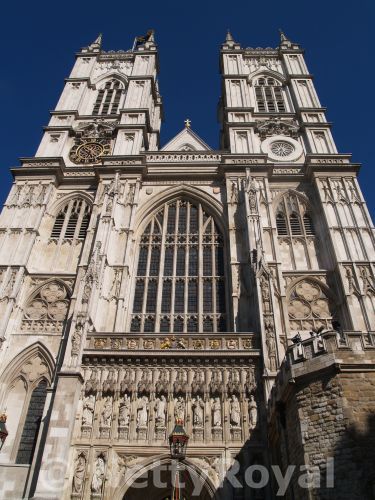
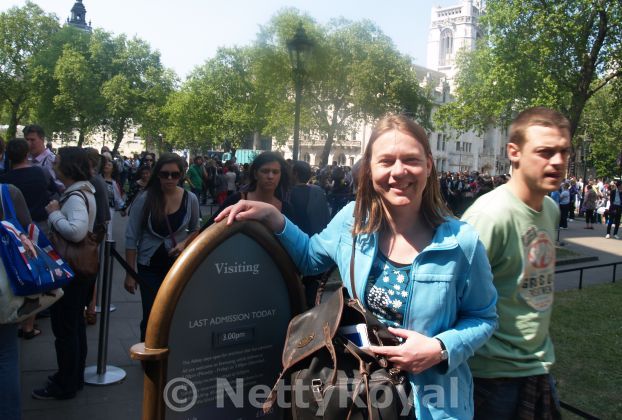
What to do the day after a royal wedding? After breakfast Anuschka went to the airport and headed home. I went outside to buy some newspapers and then returned to the hotel. As it was Queen’s Day I had to work as usual on this day. So I opened the laptop and was happy to see I could follow Queen’s Day online, despite being in London. At the end of the morning however my colleague informed me that I could also report about Queen’s Day the next day or on Monday morning. Thus I quickly packed my bag and left the hotel.
I headed for Westminster Abbey, as I knew it was open on Saturday. When I arrived I saw long queues all around the Abbey. It turned out there was one row for credit cards and one for cash money. The last one was the shortest, so after a look in my wallet I decided to stand in that queue. I bought myself the first royal wedding magazine, which was sold to people in the queue. Around one o’clock, after about one and a half hours, I finally managed to reach the entrance door of the Abbey. After paying the entrance fee I got in.
Inside the Abbey (no photographing allowed) it was surprisingly quiet. I had expected I would be hardly able to see something, but on the contrary there was more than enough space to have a look around. At the grave of the unknown soldier I admired the small but very beautiful bridal bouquet of the Duchess of Cambridge. Afterwards I enjoyed the tree and flower decoration at the aisle and the choir of the Abbey. Of course I also toured the rest of the Abbey, and had a look at all the royal and non-royal graves. At the end I bought some booklets and postcards in the shop.
Then I called Christine that I was on my way to Piccadilly Street to meet her. We met in front of a bookshop. Of course we had a look inside and I bought a few books. Christine also gave me the first wedding postcards, which she had bought early in the morning at the Abbey. Unbelievably quick. We also had a look around for some wedding souvenirs, and ended up buying tea cans with a picture of the bride and groom.
The next day I headed home after a last stroll around Westminster Abbey and Buckingham Palace. On the airport I bought myself the Hello and some other magazines with wedding reports, and the last newspapers.
Wedding news: the day after
The official wedding photographs of the Duke and Duchess of Cambridge taken by Hugo Burnand were released.
The Duke and Duchess of Cambridge appeared outside Buckingham Palace late this morning before their departure.
It was announced that the Duke and Duchess of Cambridge will not depart for their honeymoon immediately. They will spend the weekend privately in Great Britain. The Duke of Cambridge will return to work in Anglesey the next week. The locations of the private weekend and the future honeymoon overseas will not be disclosed in advance. The couple have asked to respect their privacy.
Thousands of people visited Westminster Abbey, where the flower decoration of the royal wedding could be seen. The bridal bouquet of the Duchess of Cambridge had been returned to the Abbey last night and was placed on the grave of the unknown soldier.
Biographies of bride and groom
On 16 November 2010, The Prince of Wales announced the engagement of Prince William to Miss Catherine Middleton.
Prince William of Wales
Prince William Arthur Philip Louis of Wales was born at 9.03pm on 21 June 1982, at St Mary’s Hospital, Paddington, London, Great Britain, as the elder son of The Prince of Wales and the late Diana, Princess of Wales. On 4 August 1982, Prince William Arthur Philip Louis was christened by the Archbishop of Canterbury, Dr Robert Runcie, in the Music Room at Buckingham Palace.
After attending Mrs Mynors School, Prince William became a pupil at Wetherby School in London, from 15 January 1987 until 5 July 1990. From September 1990, The Prince attended Ludgrove School in Berkshire, for five years until 5 July 1995. He then attended Eton College from July 1995 and studied Geography, Biology and History of Art at A Level.
Prince William was 15-years-old when Diana, Princess of Wales was killed in a car crash in Paris on 31 August 1997. Prince William and Prince Harry walked behind their mother’s cortege at her funeral which was held at Westminster Abbey on 6 September 1997.
After a gap year in which he visited Chile, Belize, worked on British dairy farms and visited countries in Africa, Prince William chose to study at St Andrews University in Fife, Scotland. He graduated with a 2:1 in Geography in 2005.
After a period of work experience, Prince William joined the Royal Military Academy Sandhurst as an Officer Cadet. He was commissioned as an army officer in front of Her Majesty The Queen at Sandhurst in December 2006 and joined the Household Cavalry (Blues and Royals) as a Second Lieutenant.
On St George’s Day (23 April 2008) The Queen appointed Prince William to be a Royal Knight Companion of the Most Noble Order of the Garter. He was installed at The Annual Garter ceremony held at Windsor Castle.
Although a Lieutenant in the Household Cavalry, Prince William is now training to be a search and rescue Pilot with the Royal Air Force.
At the same time, Prince William is President or Patron to a number of charities and organisations whose work he wishes to support.
Catherine Middleton
Catherine Elizabeth Middleton, also known as Kate, was born to Michael and Carole Middleton at the Royal Berkshire Hospital, Reading, on 9th January 1982. Catherine is the eldest of three children. Catherine was christened at the parish church of St Andrew’s Bradfield in Berkshire on 20th June 1982.
In May 1984, at the age of two, Catherine moved with her family to Amman in Jordan, where her father worked for two and a half years. Catherine attended a nursery school in Amman from the age of three. In September 1986, the Middletons returned to their home in West Berkshire, and Catherine started at St Andrew’s School in Pangbourne, where she remained until July 1995. Catherine went on to Marlborough College in Wiltshire, where she studied Chemistry, Biology and Art at A-level. Catherine also took part in sport on behalf of the school, playing tennis, hockey and netball and participating in athletics, particularly high jump. Catherine completed her Duke of Edinburgh Gold Award at Marlborough. Leaving Marlborough College in July 2000, Catherine undertook a gap year in which she studied at the British Institute in Florence, undertook a Raleigh International programme in Chile, and crewed on Round the World Challenge boats in the Solent.
In 2001, Catherine enrolled at the University of St Andrews, Fife, from where she graduated in 2005 with a 2:1 in History of Art. Catherine continued with her interest in sport at University, playing hockey for the University team. Catherine first met Prince William when studying at the University.
Since completing her degree, Catherine has worked for Party Pieces, a company owned and run by her parents. Alongside her work for the family business, Catherine worked in London as a part-time buyer for the clothing company Jigsaw Junior.
In 2008, Catherine launched First Birthdays, a junior brand to Party Pieces. Her role within the family business included catalogue design and production, marketing and photography.
Catherine’s hobbies include recreational sports such as hill walking, tennis, swimming, sailing, and the arts such as photography and painting.
Guestlist
Relatives of the groom
- Queen Elizabeth II of Great Britain and The Duke of Edinburgh
- The Prince of Wales and The Duchess of Cornwall
- Prince Henry of Wales
- The Duke of York
- Princess Beatrice of York
- Princess Eugenie of York
- The Earl and The Countess of Wessex
- The Princess Royal and Mr Timothy Laurence
- Mr and Mrs Peter Phillips (Autumn)
- Ms Zara Phillips and Mr Mike Tindall
- Viscount and Viscountess Linley
- The Hon Charles Armstrong-Jones
- Lady Sarah Chatto and Mr Daniel Chatto
- Samuel Chatto
- Arthur Chatto
- The Duke and The Duchess of Gloucester
- The Earl and The Countess of Ulster
- Lady Davina and Mr Gary Lewis
- Lady Rose and Mr George Gilman
- The Duke and The Duchess of Kent
- The Earl and The Countess of St. Andrews
- Lord Downpatrick
- Lady Marina-Charlotte Windsor
- Lady Amelia Windsor
- Lord and Lady Nicholas Windsor
- Lady Helen and Mr Timothy Taylor
- Prince and Princess Michael of Kent
- Lord and Lady Frederick Windsor
- Lady Gabriella Windsor
- Princess Alexandra, the Hon. Lady Ogilvy
- Mr and Mrs James Ogilvy
- Ms Marina Ogilvy
- Lady Saltoun
- Lady Sarah and Mr Neil McCorquodale
- Lord Robert and Lady Jane Fellowes
- Earl Spencer and Mrs Karen Gordon
- Lady Anne Wake-Walker
Family of the bride
- Mr Michael and Mrs Carole Middleton
- Ms Philippa Middleton
- Mr James Middleton
Royal guests
- Crown Prince Sheikh Mohammed bin Zayed al-Nahyan of Abu Dhabi
- Margrave Max and Margravine Valerie von Baden
- Princess Margarita von Baden
- Prince Philippe of Belgium, Duke of Brabant, and Princess Mathilde of Belgium, Duchess of Brabant
- Lord Brabourne
- Lady Brabourne
- The Sultan of Brunei and Raja Isteri Pengiran Anak Hajah Saleha of Brunei
- King Simeon II and Queen Margarita of Bulgaria
- Queen Margrethe II of Denmark
- King Constantine II and Queen Anne-Marie of Greece
- Crown Prince Pavlos and Crown Princess Marie-Chantal of Greece
- Prince Constantine-Alexios of Greece
- Prince Moritz von Hessen
- Princess Yvonne von Hessen
- Lady Pamela Hicks
- Fürst Philipp and Fürstin Saskia zu Hohenlohe-Langenburg
- Prinzessin Xenia zu Hohenlohe-Langenburg and Max Soltmann
- Sheikh Ahmad Hmoud Al-Sabah of Kuwait
- Prince Seeiso Bereng Seeiso and Princess Mabereng Seeiso of Lesotho
- Ian Liddell-Grainger
- Grand Duke Henri and Grand Duchess Maria Teresa of Luxembourg
- The Yang di-Pertuan Agong and Raja Permaisuri Agong of Malaysia
- Reigning Prince Albert II of Monaco and Charlene Wittstock
- Princess Lalla Salma of Morocco
- Countess Mountbatten of Burma
- The Prince of Orange and Princess Máxima of the Netherlands
- King Harald V and Queen Sonja of Norway
- Fürst Albrecht and Fürstin Angela zu Oettingen-Oettingen und Oettingen-Spielberg
- Hereditary Prince Franz-Albrecht zu Oettingen-Oettingen und Oettingen-Spielberg
- Sayyid Haitham bin Tariq al-Said of Oman
- Emir of Qatar and Sheikha Mozah bint Nasser al-Missned of Qatar
- King Michael I of Romania
- Crown Princess Margarita of Romania
- Prince Mohamed bin Nawaf bin Abdulaziz and Princess Fadwa bint Khalid bin Abdullah bin Abdulrahman of Saudi Arabia
- (?) Princess Irina von Schönburg-Glauchau
- Crown Prince Alexander and Crown Princess Katherine of Serbia
- Queen Sofia of Spain
- The Prince and The Princess of Asturias (Spain)
- King Mswati III of Swaziland with one of wifes
- Crown Princess Victoria and Prince Daniel of Sweden
- Princess Maha Chakri Sirindhorn of Thailand
- King George Tupou V of Tonga
- Princess Elizabeth of Yugoslavia
